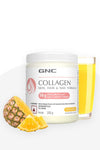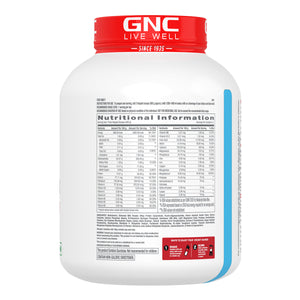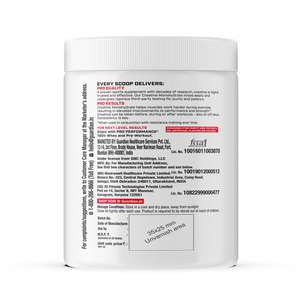
Creatine: Definition and Science-Based Benefits
Creatine is one of the most popular nutritional ergogenic aids for athletes. Let’s understand Creatine, the mysterious nutrient in this article…
What is creatine?
Creatine is a compound in the body that provides support for immediate energy production during exercise. It helps muscles make and circulate adenosine triphosphate (ATP), the energy fuel for quick intense activity of short duration, like lifting weights or sprinting.
Creatine is manufactured naturally by the liver from the amino acids arginine, glycine, and methionine. It can be consumed in meat, fish, eggs, and dairy. Creatine is mostly found in the muscles, but some are also stored in the heart, brain, and other areas. Creatine is effective in both men and women.
How creatine can help improve performance?
Research has shown that creatine supplementation increases intramuscular creatine concentrations which may help explain the observed improvements in high-intensity exercise performance leading to greater training adaptations. In addition to athletic and exercise improvement, research has shown that creatine supplementation may enhance post-exercise recovery, injury prevention, thermoregulation, rehabilitation, and concussion and/or spinal cord neuroprotection.
- Muscular Support
- Creatine plays an important role in muscle protein synthesis.
- Creatine provides support for immediate energy production during exercise.
- Creatine helps to promote cellular hydration.
- Acts as a cell volumizer
In addition to helping build muscle, creatine also assists in drawing water to the muscle and acting as a cell volumizer.
- More than 500 research studies are done on creatine supplementation on muscle and exercise capacity:
- May improve athletes’ vertical jumps, weight lifting abilities, sprint times in running and swimming up to 100 meters, and in cycling bouts of 6-30 seconds.
- May increase muscle strength when used in conjunction with resistance training.
- May result in increases in muscle mass when used in conjunction with resistance training.
- Have enhanced ergogenic effects when combined with the non-essential amino acid glutamine.
- May increase exercise capacity in the heat as it causes the body to retain water.
Did you know? Drinking plenty of water is key when supplementing with creatine. Creatine will not work if the body isn’t properly hydrated.
How does creatine work in our bodies?
Adenosine triphosphate (ATP) is the high-energy molecule that stores the energy needed for muscle contraction and immediate, short-burst activities, like weight lifting or sprinting. ATP (adenosine + 3 phosphate molecules) is synthesized in tiny energy factories inside of cells called mitochondria.
When this type of energy is needed, the cells break off a phosphate molecule from adenosine triphosphate (ATP), converting it to adenosine diphosphate (ADP), and energy is released in the process to power movement.
Creatine, which is converted in the body to creatine phosphate, donates its phosphate molecule to adenosine diphosphate (ADP) to recreate adenosine triphosphate (ATP). The more creatine phosphate there is in the cell, the longer the cell can continue to repeat this process to produce energy, up to a point.
Eventually (within a few minutes) a cell’s supply of both ATP and creatine phosphate will be used up and the mitochondria will have to produce more ATP (from glucose) before this process can be started again. People supplement with creatine to increase the amount of creatine phosphate in muscle cells.

How much creatine supplementation is safe to consume?
- Our normal diet may contain 1 – 2 grams of creatine per day, which accounts for 60-80% muscle creatine stores. Hence, dietary supplementation of creatine serves to improve the muscle creatine by 20 – 40%.
- As per ISSN (2017), The most effective way to increase muscle creatine stores is to ingest 5 g of creatine monohydrate(or approximately 0.3 g/kg body weight) four times daily for 5–7 days. Once muscle creatine stores are fully saturated, creatine stores can generally be maintained by ingesting 3–5 g/day.
- Combining creatine with carbohydrate or carbohydrate and protein has been reported to more consistently promote greater creatine retention.
- Research has also shown that short and long-term supplementation (up to 30 g/day for 5 years) is safe and well-tolerated in healthy individuals.
But, we always recommend consulting your doctor/dietician before consuming the creatine supplement.
Which form of creatine is good based on the bioavailability?
Creatine Monohydrate is the active compound of Creatine
Creatine monohydrate is creatine attached to a water molecule. This form of creatine is often taken with fast-digesting carbohydrates like drinks that contain sugar.
Besides creatine monohydrate, there are several popular forms of supplemental creatine available. Examples include PEG-creatine (creatine hydrochloride), creatine ethyl ester, and creatine alpha-ketoglutarate (AKG). These are all creatine attached to other molecules. They are designed to increase the efficiency of creatine metabolism or absorption.
As per one of the studies, Plasma levels of creatine typically peak at about 60 min after oral ingestion of creatine monohydrate. Supplementing Creatine should be done under qualified sports nutritionist supervision, whenever you buy any creatine monohydrate supplement – make sure to understand its detail and whether it is beneficial for you or not.























